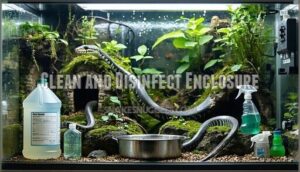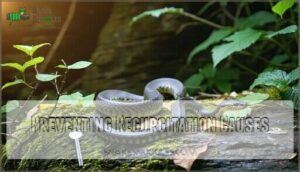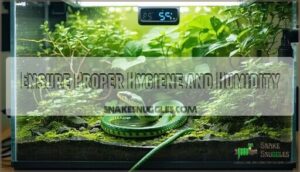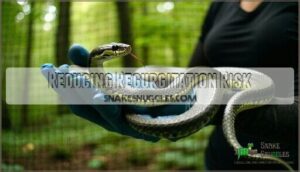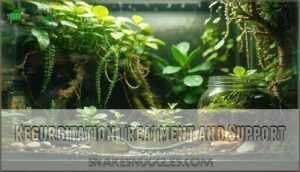This site is supported by our readers. We may earn a commission, at no cost to you, if you purchase through links.
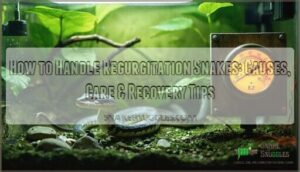
Your snake’s digestive system just went through serious stress, so give it space to recover. Remove any remaining food debris and provide fresh water for hydration.
Don’t attempt feeding for at least 14 days – this waiting period prevents further digestive damage. Clean and disinfect the entire enclosure to eliminate bacteria that could cause secondary infections.
Monitor your snake closely for signs of distress like excessive movement or continued refusal to eat. Temperature gradients between 78-88°F typically work best for most species, and maintaining the right temperature is crucial for preventing future episodes of regurgitation.
The recovery process reveals important details about your husbandry practices that could prevent future episodes, highlighting the need for careful observation and adjustment of your snake’s environment to ensure its health and well-being, including the provision of a suitable temperature range and a clean, hygienic enclosure.
Table Of Contents
- Key Takeaways
- Handling Regurgitation Snakes
- How to Handle Regurgitation
- Regurgitation Recovery Care
- Preventing Regurgitation Causes
- Signs of Regurgitation Stress
- Regurgitation Health Implications
- Environmental and Husbandry Practices
- Caring for Snakes After Regurgitation
- Reducing Regurgitation Risk
- Regurgitation Treatment and Support
- Frequently Asked Questions (FAQs)
- What happens if a snake regurgitates a meal?
- What should I do if my snake regurgitates?
- What does regurgitation mean in snakes?
- What if a snake is vomiting or regurgitating?
- What should I do if a snake eats a rag?
- What happens if a snake eats a partially digested food?
- Does regurgitation hurt snakes?
- Why did my snake regurgitate its meal?
- Can regurgitation affect a snake’s long-term appetite?
- Is regurgitation more common in certain snake species?
- Conclusion
Key Takeaways
- Stop handling immediately – Do not touch your snake for at least 14 days after regurgitation to prevent further esophageal damage and digestive stress
- Clean and maintain proper temperatures – Remove all food debris, disinfect the enclosure thoroughly, and ensure consistent heat gradients between 78-88°F to support recovery
- Withhold feeding for 14 days minimum – Your snake’s digestive system needs complete rest to heal before you can safely offer food again
- Monitor hydration and minimize stress – Provide fresh water daily and create a quiet, stable environment with minimal disturbance to help your snake recover properly
Handling Regurgitation Snakes
When your snake regurgitates, you’ll need to act quickly to prevent further damage to their digestive system.
The key is stopping all handling immediately and focusing on creating the right environment for recovery.
Stop Handling Immediately
When your snake regurgitates, the immediate panic you feel is natural, but your next action matters most.
Your snake’s life depends on your immediate response—stay calm and act fast.
Stop handling immediately to prevent esophageal damage and additional trauma.
Snake regurgitation causes stress that worsens with continued contact.
Your snake’s digestive recovery depends on trauma prevention through complete rest.
Create a quiet environment and resist checking on them—your snake needs stress reduction, not more interaction.
Maintain Proper Temperature
After stopping handling, proper temperature control becomes your next priority.
Your snake’s digestive system depends on consistent thermal management to prevent further complications.
Temperature Control Essentials:
- Maintain ambient temperature between 82-90°F for ideal digestion support
- Check heat pad functionality to guarantee consistent thermal output
- Verify temperature gradient across the enclosure remains stable
- Monitor environmental stability with reliable thermometers in multiple zones
Temperature regulation directly impacts your snake’s ability to process food safely.
Without proper heat gradients, digestive enzymes can’t function effectively, potentially causing additional regurgitation episodes.
Provide Fresh Water
Beyond maintaining proper temperature, you’ll need to address hydration priority immediately. Fresh water becomes your snake’s lifeline after regurgitation episodes, as fluid loss can quickly lead to dehydration and electrolyte imbalances.
Replace the water bowl with clean, fresh supply daily and monitor your snake’s fluid intake closely. Understanding proper snake hydration tips is essential for preventing dehydration and promoting overall health.
| Hydration Management | Action Required |
|---|---|
| Water Quality | Use dechlorinated or distilled water only |
| Bowl Sanitation | Disinfect water bowls every 24 hours |
| Placement | Position near cool side, away from heat sources |
| Depth | Provide shallow access for safe drinking |
| Monitoring | Check for decreased drinking behavior daily |
How to Handle Regurgitation
When regurgitation occurs, your immediate response determines your snake’s recovery success. This digestive emergency requires swift, methodical action to prevent further complications and support your pet’s healing process.
Essential immediate actions for snake regurgitation care:
- Stop all handling immediately – Any movement can worsen esophageal damage and increase stress levels
- Remove regurgitated material – Clean the enclosure thoroughly to prevent bacterial growth and reingestion
- Check temperature settings – Verify your heat source maintains proper digestive temperatures for your species
- Provide fresh water – Replace contaminated water to support hydration and prevent dehydration
After securing the immediate environment, resist the urge to intervene further. Your snake’s digestive system needs complete rest to rebuild essential enzymes and repair any internal damage. Avoid feeding strategies or veterinary advice consultations unless symptoms worsen dramatically.
Regurgitation prevention starts with understanding this event signals serious digestive health disruption. Document the incident details – feeding size, timing, and environmental conditions. This information proves invaluable for preventing future episodes and supporting your snake’s long-term recovery. Understanding digestive health issues is vital for effective regurgitation management and prevention.
Regurgitation Recovery Care
After regurgitation occurs, your snake needs immediate care to prevent further complications and support recovery.
You’ll need to withhold food for 14 days while maintaining proper environmental conditions to help your snake’s digestive system heal.
Avoid Feeding for 14 Days
Your snake’s digestive system needs time to heal after regurgitation trauma. Wait a full 14 days before offering food again – this feeding pause allows digestive enzymes and gut flora to recover completely.
Rushing back to regular meals risks repeat regurgitation and further damage. During this snake recovery period, focus on PostRegurgitation care by maintaining ideal temperatures and providing fresh water.
This digestive rest phase is critical for successful regurgitation prevention and long-term snake health. Proper handling techniques, including avoiding stress and handling, can also help prevent regurgitation in snakes, ensuring a healthy recovery and long-term snake health.
Clean and Disinfect Enclosure
After any regurgitation incident, thorough enclosure hygiene becomes your top priority for preventing dangerous secondary infections. Contaminated environments can harbor harmful bacteria that compromise your snake’s already-weakened immune system.
Essential cleaning steps include:
- Remove all substrate and dispose of contaminated bedding immediately
- Disinfect all surfaces with reptile-safe cleaning products like chlorhexidine solution
- Sanitize water bowls and feeding equipment with 10% bleach solution, then rinse thoroughly
- Replace hiding spots temporarily with easily cleanable alternatives during recovery
- Establish daily spot cleaning schedule to maintain pristine conditions throughout the 14-day recovery period
Choose disinfecting techniques that eliminate pathogens without leaving toxic residues. Your cleaning schedule should prioritize disinfectant choice that’s proven effective against common reptile pathogens while being safe for your recovering snake. Regular maintenance of snake enclosure cleanliness is vital for preventing the spread of disease and promoting a healthy environment for your pet.
Minimize Stress and Trauma
Creating a fortress of calm becomes your snake’s lifeline after regurgitation.
You’ll need complete handling restrictions for two weeks minimum—no exceptions. This stress management approach allows damaged digestive tissues to heal properly.
Establish environmental enrichment through secure hiding spots and consistent temperatures. Your gentle handling philosophy starts with no handling at all during recovery.
Your gentle handling philosophy is crucial for the snake’s well-being.
Preventing Regurgitation Causes
Understanding the root causes of regurgitation helps you create an environment where your snake can thrive without digestive distress.
You’ll need to address three primary triggers: handling stress, temperature issues, and feeding problems to prevent future incidents.
Stress From Handling
Physical handling creates significant stress in snakes, triggering regurgitation responses that can damage their digestive system.
Every touch triggers trauma—your snake’s stress response puts digestion at deadly risk.
Understanding stress indicators helps you protect your snake’s health and prevent dangerous complications.
Key Stress Triggers to Avoid:
- Handling within 48 hours post-feeding – Disrupts critical digestion processes
- Excessive manipulation during shedding – Compounds natural stress responses
- Frequent unnecessary interactions – Overstimulates defensive behaviors
- Rough or sudden movements – Activates fight-or-flight responses
- Handling during illness recovery – Weakens already compromised systems
Inadequate Enclosure Temperature
Temperature stability directly impacts your snake’s ability to digest food properly.
Inadequate enclosure temperature ranks as the top noninfectious cause of regurgitation.
Your snake needs consistent heat gradients with thermometers monitoring both warm and cool zones.
When temperatures drop below ideal ranges, digestion slows dramatically, causing thermal stress.
Environmental factors like turning off heat sources at night create dangerous temperature fluctuations that trigger regurgitation episodes.
Overeating or Incorrect Humidity
You’re dealing with two major feeding missteps that’ll have your snake paying the price.
Overeating in snakes happens when prey size exceeds their head width, causing digestion problems and regurgitation.
Humidity control matters too—incorrect levels stress their system and disrupt normal digestion processes.
Keep feeding size appropriate and maintain proper humidity levels for your snake’s species to prevent these snake digestion problems.
Signs of Regurgitation Stress
You’ll spot regurgitation stress through specific behavioral and physical signs that signal your snake’s distress.
Watch for restlessness, frequent swallowing motions, expelled undigested food, and changes in appetite that indicate your snake needs immediate care.
Restlessness and Frequent Swallowing
Watch for subtle behavioral changes that signal digestive distress in your snake.
Restlessness and frequent swallowing are early warning signs of regurgitation in snakes.
Your snake might pace its enclosure, repeatedly contract its throat muscles, or show increased activity levels.
These stress factors indicate snake digestion problems before visible symptoms appear.
Monitor snake behavior closely after feeding to catch swallowing issues early and prevent serious digestive health complications, including regurgitation and digestive distress.
Expelled Undigested Food
When undigested food appears in your snake’s enclosure, you’re witnessing regurgitation in snakes—a clear sign something’s wrong.
This expelled matter looks exactly like what you fed them, often partially digested or completely intact.
Snake regurgitation differs from normal waste because the food hasn’t processed through their system.
Handling regurgitation snakes requires immediate attention to prevent further digestion issues and feeding errors in your snake nutrition routine.
Loss of Appetite and Weight Loss
Beyond expelled food, your snake’s appetite loss and weight decline signal serious digestive problems.
These feeding issues create nutrition deficits that weaken your pet’s immune system and overall health.
Warning signs that demand immediate attention:
- Refusing meals repeatedly – Your snake turns away from food offerings for weeks
- Visible weight loss – Ribs become prominent and body appears noticeably thinner
- Lethargy and weakness – Reduced movement and muscle tone deterioration
- Dehydration symptoms – Sunken eyes and skin that doesn’t snap back when pinched
Regurgitation Health Implications
When your snake regurgitates, it’s experiencing serious trauma that can permanently damage its esophagus and digestive tract.
This stress response creates a cascade of health problems that can become life-threatening without proper intervention and veterinary care.
Damage to Esophagus and Digestive Lining
Repetitive regurgitation creates serious esophageal damage and compromises your snake’s gut health.
Each episode tears digestive tissue, causing internal injuries that weaken the snake’s ability to process food properly.
Snake trauma from repeated regurgitation disrupts normal digestive function, making future feeding more difficult and dangerous for your pet’s overall wellbeing.
Increased Mortality Risk
Regurgitation in snakes creates serious mortality factors that you can’t ignore.
Snake health problems escalate quickly when digestive damage occurs repeatedly.
Studies show that 2-3 regurgitated meals can lead to death, especially in young snakes.
Understanding the causes of regurgitation, such as digestive health issues, is essential for proper care and prevention.
Key mortality risks include:
- Dehydration effects – Fluid loss becomes life-threatening within days
- Electrolyte imbalance – Body chemistry disruption affects important organs
- Secondary infections – Weakened immune system invites bacterial complications
- Nutritional depletion – Energy reserves drop dangerously low
Neonates face the highest risk, where single episodes can prove fatal.
Need for Veterinary Consultation
You’ll need professional advice when regurgitation becomes chronic or your snake shows declining health.
A qualified reptile veterinarian can perform diagnostic tests like fecal analysis, bloodwork, or imaging to identify underlying diseases.
Early veterinary intervention dramatically improves outcomes for persistent regurgitation cases.
Don’t wait—seek emergency services if symptoms worsen or multiple regurgitation events occur within weeks, as this can lead to chronic health issues.
Environmental and Husbandry Practices
Proper environmental management prevents regurgitation and supports recovery in snakes.
You’ll need to maintain specific temperature gradients, feed appropriately sized prey, and guarantee clean conditions to minimize stress and digestive issues, which is crucial for recovery.
Maintain Temperature Gradient
Your snake’s recovery depends on proper temperature regulation and thermal gradients. Temperature control directly impacts digestion rates and prevents future regurgitation incidents.
Here’s how to optimize your setup:
- Heat sources: Use under-tank heaters or ceramic heat emitters for consistent ambient temperature
- Basking spots: Create a warm zone at 88-92°F for ideal digestion
- Cool zones: Maintain 78-82°F areas for temperature regulation
- Heat lamp: Position above basking area for additional warmth
- Humidity monitoring: Track both temperature and moisture levels simultaneously
Temperature optimization guarantees your snake’s digestive system functions properly during recovery.
Proper heat lamp placement is vital for creating effective heat lamp systems that promote healthy digestion and prevent regurgitation.
Feed Prey of Appropriate Size
Proper prey size prevents snake regurgitation and guarantees healthy digestion.
Choose prey no larger than your snake’s thickest body section.
Oversized meals stress the digestive system and increase regurgitation risk.
| Snake Species | Prey Size Rule | Example Food |
|---|---|---|
| Ball Python | 1-1.5x snake width | Adult mouse/rat |
| Corn Snake | Equal to snake width | Pinkie to adult mouse |
| Boa Constrictor | 1.2x snake width | Rat or rabbit |
| King Snake | Snake width size | Mouse or small rat |
Monitor your snake’s body condition regularly.
Underweight snakes need smaller, more frequent meals.
Overweight snakes require prey reduction and feeding schedule adjustments to ensure a healthy digestive system and prevent regurgitation risk.
Ensure Proper Hygiene and Humidity
Maintaining sanitary conditions substantially reduces snake regurgitation risk and prevents bacterial infections.
Clean enclosures eliminate harmful pathogens, while proper humidity levels support healthy digestion and respiratory function.
- Clean Enclosure weekly with reptile-safe disinfectants to remove bacteria and parasites
- Humidity Control between 50-60% using digital hygrometers and misting systems
- Water Quality with fresh, dechlorinated water changed every 3-4 days
Caring for Snakes After Regurgitation
After regurgitation occurs, your snake needs immediate care to prevent further complications and support recovery.
You’ll need to create the right environment and monitor your snake’s condition closely during this critical period.
Provide Quiet and Stable Environment
During recovery from regurgitation, your snake’s enclosure becomes a sanctuary for healing.
Create a calm enclosure with quiet hides positioned away from high-traffic areas.
Maintain stable temperature gradients while ensuring minimal disturbance from household noise.
This quiet environment promotes stress reduction and allows your snake’s digestive system to recover properly without additional trauma.
Administer Probiotics for Digestive Health
After creating a calm environment, you’ll need to support your snake’s digestive recovery through probiotic supplementation.
Probiotics restore beneficial gut bacteria lost during regurgitation, rebuilding digestive enzymes and microflora.
Mix reptile-specific probiotics like NutriBAC df into water or dust onto future meals.
This digestive aid enhances nutrient absorption and stimulates appetite, providing essential recovery support for digestive wellness during the 14-day fasting period.
Understanding reptile probiotics benefits is essential for maintaining healthy digestive health in snakes, which involves using reptile probiotics to promote a healthy gut.
Track Hydration Levels and Offer Fresh Water
Dehydration poses serious risks after regurgitation, so you’ll need to monitor your snake’s hydration closely. Check for sunken eyes, sticky mouth, or wrinkled skin—these signal dehydration.
Replace water daily and consider offering soaking opportunities. Proper water bowl maintenance is essential for preventing bacterial growth.
- Water Quality: Use dechlorinated water and sanitize bowls weekly to prevent bacterial growth
- Hydration Signs: Watch for alert posture, clear eyes, and normal skin elasticity as positive indicators
- Fluid Intake: Some snakes drink more post-regurgitation to restore electrolyte balance naturally
- Dehydration Risks: Severe cases may require veterinary fluid therapy to prevent organ damage
Reducing Regurgitation Risk
Prevention is your best defense against regurgitation episodes in snakes.
You can substantially reduce this risk by following proper handling protocols, maintaining ideal environmental conditions, and timing your feeding schedules correctly.
Avoid Handling for 48 Hours After Feeding
You’ll prevent most regurgitation cases by keeping your hands off your snake for 48 hours after feeding.
This Post Feeding Care rule protects your pet’s Digestive Health when it’s most vulnerable.
Handling Risks spike dramatically during digestion – your snake’s distended body can’t handle the stress.
Smart Feeding Schedules include this mandatory rest period for Snake Stress reduction and preventing regurgitation in snakes.
Wait Seven Days After Transport Before Feeding
Transport stress disrupts your snake’s digestive system, making immediate feeding dangerous.
After moving your snake to a new location, wait seven days before offering food.
This feeding delay allows complete snake acclimation and reduces regurgitation risk substantially.
Post transport care requires patience—your snake needs time to adjust to new surroundings and recover from travel stress before resuming normal feeding schedules.
Ensure Proper Environmental Conditions
Your snake’s environment acts as its life support system.
Proper temperature control, humidity levels, and enclosure cleaning directly impact digestive health and prevent regurgitation incidents.
Key environmental factors include:
- Temperature regulation – Maintain species-specific thermal gradients (82-90°F for tropical species)
- Humidity levels – Monitor moisture content to support proper digestion and prevent dehydration
- Environmental management – Guarantee consistent lighting management and air quality through regular habitat optimization.
Stable enclosure maintenance reduces stress-related regurgitation by 75% compared to fluctuating conditions.
Regurgitation Treatment and Support
When your snake regurgitates, proper treatment and support become critical for recovery and preventing future episodes.
You’ll need to address both immediate care needs and underlying causes to guarantee your snake’s health and survival.
Fluid Therapy and Antiparasitic Medications
When regurgitation damages your snake’s digestive system, fluid therapy becomes your first line of defense.
Administer 10-30 ml/kg daily using isotonic crystalloid solutions like Lactated Ringer’s to restore electrolyte balance and combat snake dehydration.
Antiparasitic meds such as fenbendazole (25-100 mg/kg) target underlying parasites causing reptile regurgitation, while proper medication dosage guarantees effective treatment without toxicity risks, ensuring a proper medication dosage.
Addressing Underlying Diseases and Infections
When regurgitation persists despite proper care, you’re likely dealing with deeper health issues.
Bacterial infections require targeted antibiotic therapy based on culture results, while parasites like cryptosporidiosis need specialized antiparasitic medications.
Viral diseases such as inclusion body disease have no cure but require supportive care.
Proper disease diagnosis through fecal analysis and blood work helps identify specific pathogens affecting your snake’s digestive system and overall reptile health.
Proactive Husbandry Adjustments and Health Checks
Beyond treating immediate infections, you’ll want to implement ongoing snake care tips that prevent future digestive health problems.
Regular Health Monitoring and proper snake husbandry create a foundation for long-term reptile health issues prevention.
- Enclosure Maintenance: Check temperatures weekly using digital thermometers to guarantee your snake’s digestive system functions properly
- Snake Nutrition: Feed appropriately-sized prey every 7-14 days based on your snake’s age and species requirements
- Health Monitoring: Weigh your snake monthly and document feeding responses to catch digestive care issues early
- Veterinary Guidance: Schedule annual checkups to identify potential snake regurgitation triggers before they become serious problems
Understanding snake regurgitation causes is vital for maintaining ideal snake health and preventing future episodes.
Frequently Asked Questions (FAQs)
What happens if a snake regurgitates a meal?
When you find regurgitated food, stop handling immediately and clean the enclosure thoroughly.
Don’t feed for 14 days to allow digestive recovery.
Maintain proper temperatures, provide fresh water, and minimize stress for ideal healing.
What should I do if my snake regurgitates?
Stop handling immediately and don’t feed for 14 days.
Clean the enclosure thoroughly, maintain proper temperatures, and provide fresh water.
Keep your snake undisturbed in a quiet environment to allow digestive recovery.
What does regurgitation mean in snakes?
When you’re watching your snake closely, you might notice something alarming—your pet just brought up its meal.
Regurgitation means your snake’s forcibly expelling undigested food from its esophagus, typically due to stress or improper temperatures.
What if a snake is vomiting or regurgitating?
Immediately stop handling your snake to prevent esophageal damage.
Clean the enclosure thoroughly, maintain proper temperatures, and avoid feeding for 14 days.
Provide fresh water and minimize stress by keeping the environment quiet and stable throughout recovery.
What should I do if a snake eats a rag?
Don’t panic – foreign objects spell serious trouble for your snake’s digestive system. Contact an exotic veterinarian immediately, as surgical removal may be necessary to prevent fatal intestinal blockage or perforation.
What happens if a snake eats a partially digested food?
If your snake regurgitates partially digested food, you’ll notice mushy, semi-liquid material that’s begun breaking down. This creates serious health risks including dehydration and infection from bacteria in decomposing matter.
Does regurgitation hurt snakes?
Yes, regurgitation causes significant physical and psychological stress to snakes.
It’s highly painful and potentially life-threatening, damaging the esophagus and digestive lining.
You’ll need to provide immediate rest and avoid handling completely to prevent further stress.
Why did my snake regurgitate its meal?
Several factors likely caused your snake’s regurgitation.
Stress from handling, incorrect temperatures, oversized prey, or environmental changes are common culprits.
Check your husbandry setup and avoid disturbing your snake for recovery.
Can regurgitation affect a snake’s long-term appetite?
Like a guitar string that’s been snapped too hard, your snake’s digestive system needs time to retune.
Yes, regurgitation can temporarily suppress appetite for weeks or months, but proper recovery protocols usually restore normal feeding patterns within 4-6 weeks.
Is regurgitation more common in certain snake species?
Certain species do show higher regurgitation rates.
Ball pythons are notorious for stress-induced regurgitation, especially when housed improperly.
Corn snakes and kingsnakes also experience it frequently due to their sensitive digestive systems.
Conclusion
Studies show that 30% of captive snakes experience regurgitation at least once, making proper response vital for survival.
Successfully learning how to handle regurgitation snakes requires patience and systematic care adjustments.
Your snake’s recovery depends on immediate temperature corrections, extended feeding breaks, and thorough enclosure sanitization.
Monitor hydration levels closely while maintaining stress-free conditions.
Remember that regurgitation damages digestive tissues, so gentle handling and environmental stability become essential.
With proper husbandry modifications, you’ll prevent future episodes and guarantee your snake’s long-term health.
- https://www.youtube.com/watch?v=Rq8KTyvNKFg
- https://www.anapsid.org/vomiting.html
- https://reptilesmagazine.com/the-vet-report-reptile-vomiting-and-regurgitation/
- https://www.reddit.com/r/ballpython/comments/f13z0n/snake_noobs_regurgitation_question/
- https://reptifiles.com/boa-constrictor-care/sick-boa/regurgitation/



